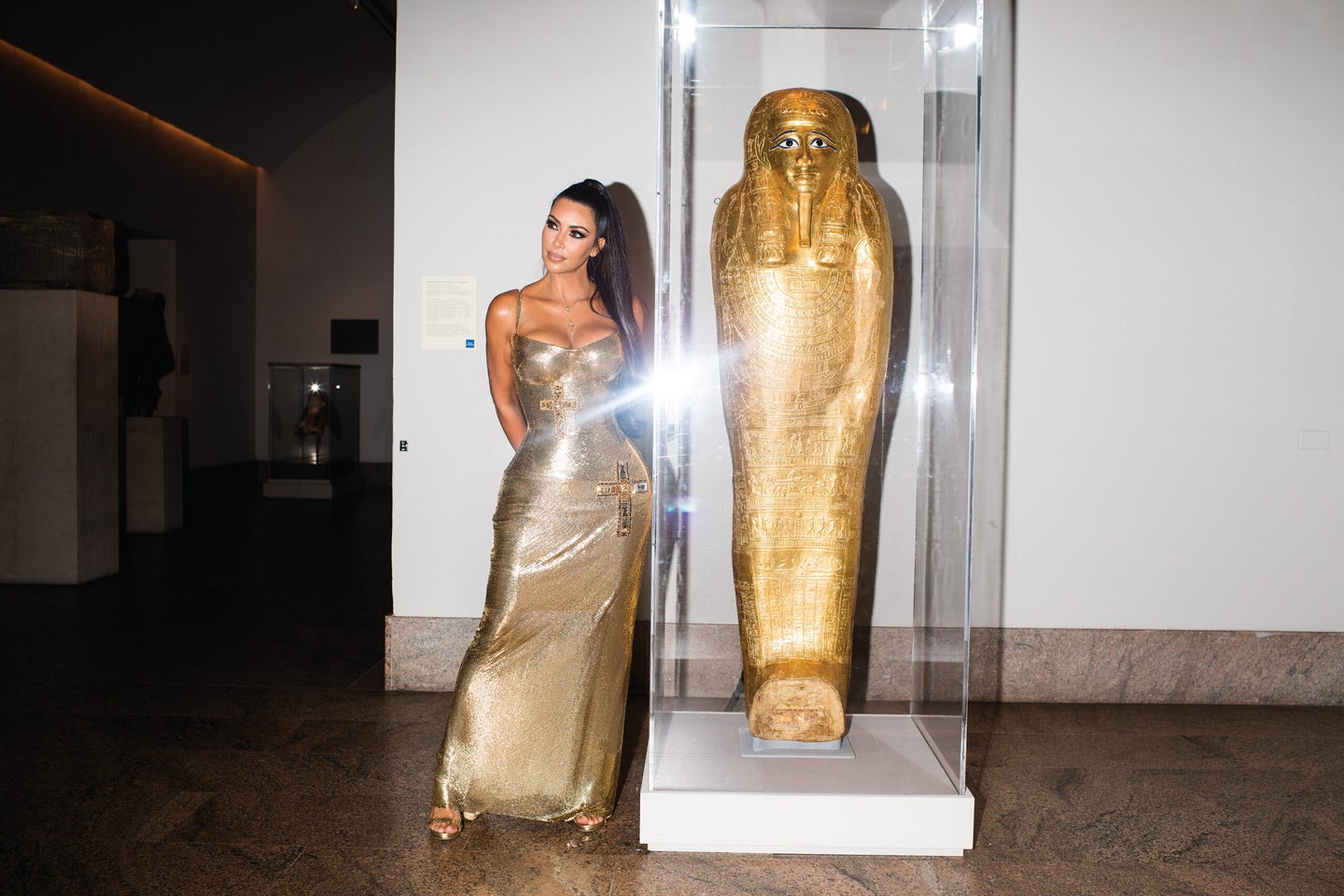A viral photo of Kim Kardashian with a golden coffin helped solve an antiquities mystery
Kim Kardashian posed next to the glistening coffin at the 2018 Met Gala. The image went viral and then things got really interesting.

Kim Kardashian West has a superpower: She’s so famous that she can solve crimes just by posing next to a piece of evidence. No, seriously—that’s exactly what happened in a so-ridiculous-you-couldn’t-write-it art caper involving New York’s Metropolitan Museum, shady art dealers, a golden Egyptian coffin, and a photo of Kardashian West uncovered by historian Ben Lewis on his podcast, Art Bust.
Let me explain.
The tip-off
At the 2018 Met Gala, Kardashian West wore a shiny gold dress. Also dolled up in gold was one of the museum’s highest-profile exhibits: Nedjemankh’s coffin from the 1st Century BC, which the Met had recently spent $4 million dollars acquiring. We’re not going to make the same cracks as every other outlet about matching gold outfits and mascara, but suffice it to say, the photo struck a chord with some people and went viral.
And that’s where things get weird.
Unpaid labor
Photographers (and writers) often have to deal with late payments and unpaid invoices, and apparently, so do looters.
The photo of Kardashian West and the coffin was seen around the world. In Egypt, one of the looters who dug it from the ground saw it and recognized the coffin. And, because he hadn’t been paid for the “assignment” he’d taken on in 2011 (seven years prior), he sent a tip-off to an informant “in the Middle East”.
A week or two after the Met Gala, the informant emailed the photo to Matthew Bogdanos, a Manhattan assistant district attorney who heads up the antiquities trafficking unit. It was the break he needed in a case he’d been working on for five years.
(Honestly, if I had the power to bring the DA down on the people who haven’t paid me, I’d take it!)
How the coffin got to The Met
The coffin took a convoluted route to the Met. For the full breakdown, check out Lewis’ podcast or his write up in The Times, but here’s the bulleted version:
- The coffin was looted from the Minya region of Egypt in 2011, during the Egyptian Revolution. The robbers dug it up, dumped the mummified remains of Nedjemankh in the Nile, and presumably sold it.
- In 2013, it was smuggled out of an Egyptian port, “probably Alexandria, probably in a container,” and sent to the United Arab Emirates where it went into the possession of Hassan Fazeli, an art dealer.
- Fazeli created a fake export certificate declaring the coffin to be of Greco-Roman origin and FedExed it on to Europe.
- We don’t know exactly what happened next, but it came into the possession of Roben Dib, the manager of the Dionysos Gallery in Hamberg, Germany. Dib arranged for the coffin to be restored and, according to The Times, faked an Egyptian export license showing that it had been legally exported in 1971. (The Unesco World Heritage Convention of 1972 banned the export of cultural heritage.)
- The coffin was next sent to “French antiquities scholar and dealer Christophe Kunicki and his partner Richard Semper” who offered it to Diana Patch, the Met’s curator for Egyptian art.
- Under recommendation from Patch, the Met spent $4 million dollars acquiring it.
How things stand now
While Bogdanos’ grand jury investigation is still ongoing, there have already been some consequences internationally.
French authorities have arrested and charged Kunicki and Semper. Dib was arrested by German authorities, though it’s unclear if he’s been charged. And the Met surrendered the coffin to the Manhattan DA who sent it back to Egypt, where it will be displayed in Cairo’s new Egyptian Museum.
Photos can go far
While this might all seem like a fun caper, it does nicely highlight how sharing your photos online can have seriously unintended consequences. There are many areas around the world that are suffering from Instagram-inspired over-tourism, for similar reasons. If you take anything away from this article, remember that once an image is online, it’s kind of out of your hands—and there isn’t a huge amount you can do to protect it.
That, and don’t let Kim Kardashian West stand near any incriminating evidence.
